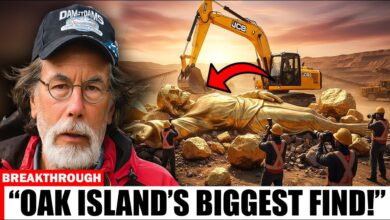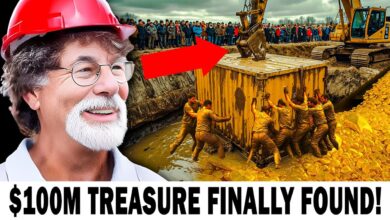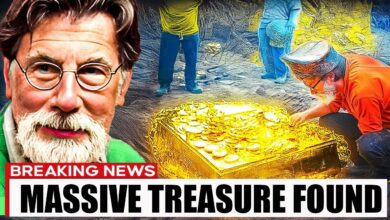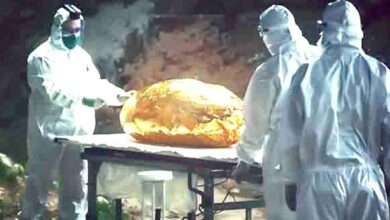The Curse of Oak Island: NEW GEOPHYSICAL SCAN Reveals Huge Anomaly (Season 10)
The Curse of Oak Island: NEW GEOPHYSICAL SCAN Reveals Huge Anomaly (Season 10)

Hey, whatever he is, oh Jeremy, how are you?
I’m great, good to see you guys. Marty Lagina, along with his son Alex and Craig Tester, are meeting with geoscientists Jeremy Church and Burton Cosgrove in the research center.
Due to the delay of the garden shaft reconstruction and also in light of the recent discoveries made on the western side of the island, Jeremy, you guys brought some high-tech stuff that we’re going to deploy on the island?
Yeah, the Oakland team has invited Jeremy and Burton to conduct a comprehensive geophysical scan of all of Oak Island’s 32 four-acre lots. So the unit is known as EM 31-8. Okay, it is a near-production prototype, but it’s based on an older technology that’s been around for a few decades now. It’s just kind of a new riff on it. What it measures is conductivity, and it’s going to collect that data down to a depth of 30 feet.
Cool. So, you know, wherever you’re going to have metallic objects on the island, obviously this thing’s going to pick it up real nice. But you also could be picking up things like old foundations where the soil’s been disturbed or there are large anomalies. These are all going to be clues to the activity of previous occupants of the island.
Sounds good.
Yeah, we were talking about what we’re doing in the swamp. That’s my first suggestion! I know that spot on, Alex. It’s warm right now, but the bugs aren’t out yet. That would be a really good place to start, and you can take it in a boat, no problem, right?
Yeah, definitely.
Another reason for starting with the swamp is a couple of years back, you guys had that ship-shaped anomaly in the swamp, and we tried to dig it. We didn’t have a lot of success, but if this equipment can give us another look at that area, just to confirm and hopefully get more meaningful information.
Yeah, absolutely.
It was during a seismic scanning operation conducted in 2018 by Jeremy and his colleagues from Eagle Canada that identified a massive anomaly resembling the size and shape of an ancient galleon ship in the middle of the swamp. Although the team has been unable to verify just what the feature is, since then they’ve unearthed numerous pieces of believed sailing vessels dating from as late as the 17th century to as early as the 3rd century A.D.
Now it is the team’s hope that Jeremy and Burton can identify new clues, not only on dry land but also in the swamp, that might help them obtain new permits to drain it and confirm just what it may contain.
We’re here to try to solve an incredible mystery.
Is there a swamp component to solving that mystery? I believe there is, and I absolutely want to pursue it.
If we can get data from you early on to incorporate in part of the permit, that’d be great.
Yeah, so we’ll get you going. Thanks, guys. Seriously, guys, go get it. Thank you. Appreciate it.
Later that afternoon, Jeremy, gentlemen, hello, good to see you.
Hello, Craig, good to see you. Tony, nice to see you.
Diver Tony Sampson has joined Craig, Alex, Jeremy Church, and Burton Cosgrove at the swamp as they prepare to begin conducting their survey using the EM-31A scanning device.
So how’s it going to work? Really, the key to all this is getting good lines. It’s all about the grid that we do. We need really a tight grid so we don’t miss any small anomalies, and that’s part of the reason why Tony’s going to be in the water rather than rowing.
Yeah, but to get the straightest, cleanest lines, you can’t beat human power.
In order to scan the swamp, Tony will guide the boat in straight grid lines. The EM-318 ground conductivity device measures the magnetic field emitted by metallic objects or structures that may be buried as much as 30 feet deep underground.
Although the device can register immediate preliminary results, the data that it collects will require several weeks of post-processing in order to generate a three-dimensional map of potential man-made targets.
Okay, gentlemen, um, I’m gonna go and do some other things, but I’ll check back in every once in a while and… okay, thanks, see you later, Craig.
Okay, what do we need to do? All right, let’s get this on the boat.
The first thing we need to do in the swamp is to determine actual targets.
Okay, we’re good. Non-destructive, non-invasive, and if we come up with a legitimate target or targets…
Okay, so you guys got it all set up?
I believe so. Then we will begin that process of applying for permits and try to come up with a plan.
Here we go. Thank you, sir. Best of luck.
Thank you.
How’s that for a starting point, guys?
Yeah, that’s a good one.
Yep, we’re online.
Still good?
Yeah.
Like, oh, through the roof?
Yeah.
What level was that at?
It’s all through them, so… really?
Yeah, it’s basically sitting on top of the seismic anomaly too.
There’ll be some metallic objects in there.
Wow.
Possible metal objects in the same location where Jeremy Church detected a 200-foot long ship-shaped anomaly four years ago.
Potentially found more evidence that the swamp could contain the wreck of a centuries-old treasure galleon. And if so, could it be related to The Stone Road, as well as the other discoveries made around the island that may be Portuguese in origin?
Good to go, Tony?
Good to go.
Boom! Something was happening right there.
Yeah, another hit there.
Another hit there.
Yeah, I have to admit that every time we’re dug in the swamp, we found stuff that seems to be significant. We have all kinds of stuff from the swamp that’s intriguing.
We have the enigmatic Stone Road that anyone can tell is a man-made feature and doesn’t make any sense to be in a swamp.
We have bits of wood that have very peculiar dates on them from the swamp. So, in order to finish this quest, we have to finish the swamp.
Foreign.








